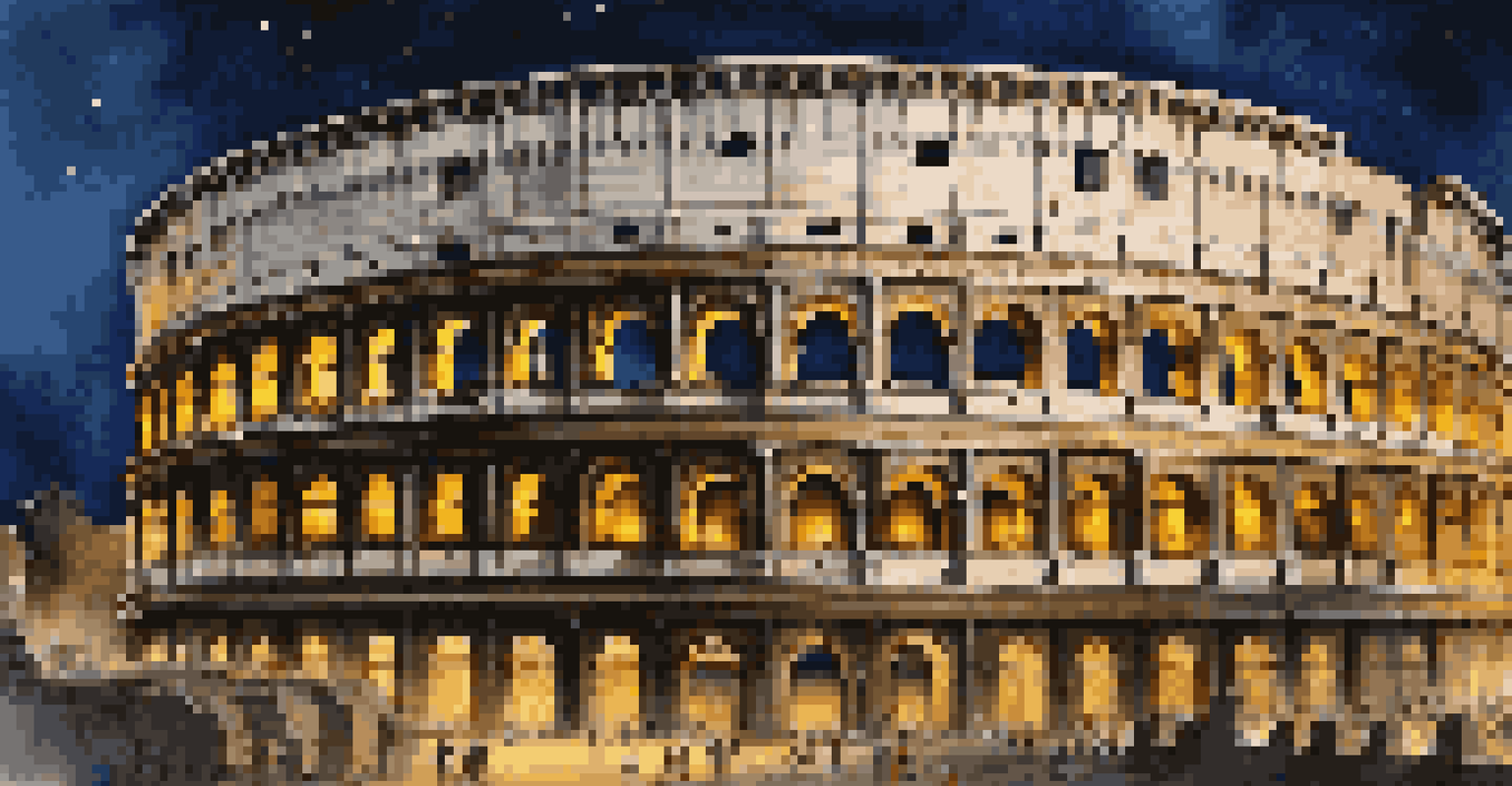Iconic Landmarks: Art and Architecture in Major Cities

The Eiffel Tower: A Symbol of Parisian Elegance
Standing tall on the Champ de Mars, the Eiffel Tower is more than just a structure; it's a symbol of Paris itself. Designed by Gustave Eiffel for the 1889 Exposition Universelle, this iron lattice tower has become an iconic representation of French artistry and engineering. With its intricate design and impressive height, it attracts millions of visitors each year, eager to capture its beauty from every angle.
Architecture is the art of how to waste space.
Beyond its aesthetic appeal, the Eiffel Tower also represents the innovative spirit of the late 19th century. Its unique design broke away from traditional architectural norms, showcasing how iron could be both functional and beautiful. This landmark's presence in the City of Light serves as a reminder of the boldness that characterizes Parisian culture.
Visiting the Eiffel Tower is an experience like no other. Whether you're enjoying a picnic on the lawns below or ascending to its observation decks, the views of the Seine River and the sprawling cityscape are breathtaking. This blend of art, history, and engineering makes the Eiffel Tower a must-see landmark for anyone traveling to Paris.
The Colosseum: Rome's Ancient Architectural Marvel
The Colosseum, an iconic symbol of Rome, stands as a testament to the grandeur of ancient architecture. Built between 70-80 AD, this amphitheater could hold up to 80,000 spectators, showcasing the Romans' architectural ingenuity. Its design allowed for elaborate spectacles like gladiator contests, making it a central hub for entertainment in its time.

What sets the Colosseum apart is its use of concrete and the arch, both of which were revolutionary for that era. The structure’s massive scale and intricate design exemplify the engineering prowess of the ancient Romans. Even today, it captivates visitors with its remarkable history and impressive ruins, providing a glimpse into the past.
Iconic Landmarks Reflect Cultures
Famous structures like the Eiffel Tower and the Colosseum embody the artistic and historical significance of their respective cultures.
Walking through the Colosseum, you can almost hear the echoes of the crowds from centuries ago, creating a visceral connection to history. Each stone tells a story, reminding us of the cultural significance of this landmark. It serves not only as an architectural wonder but as a monument to the legacy of the Roman Empire.
The Great Wall of China: A Monument of Perseverance
Stretching over 13,000 miles, the Great Wall of China is a monumental feat of engineering and an enduring symbol of Chinese history. Originally built to protect against invasions, this wall showcases the dedication and perseverance of the ancient Chinese people. Its construction spanned several dynasties, each adding their unique touch to the wall’s design.
The details are not the details. They make the design.
The Great Wall is not just a single wall but a series of walls and fortifications that weave through picturesque landscapes. Each section reflects different architectural styles, with watchtowers and battlements designed for specific defensive purposes. This diversity highlights the adaptability and ingenuity of the builders over the centuries.
Visitors to the Great Wall are often struck by its sheer scale and the breathtaking views it offers. Hiking along its paths, you can imagine the historical events that took place here. The wall stands as a powerful reminder of resilience, inviting people from around the world to appreciate its beauty and significance.
The Sydney Opera House: A Modern Architectural Icon
With its distinctive sail-like design, the Sydney Opera House is a marvel of modern architecture that has become synonymous with Australia. Designed by Danish architect Jørn Utzon, this cultural hub opened in 1973 and has since hosted countless performances, making it a cornerstone of the arts in Sydney. Its unique shape and location on Bennelong Point make it one of the most photographed buildings in the world.
The construction of the Opera House was a bold statement of creativity and ambition, utilizing innovative techniques and materials. Its shell-like roofs are not only visually stunning but also acoustically functional, enhancing the experience for audiences. This architectural masterpiece showcases how design can harmoniously blend with its natural surroundings.
Architectural Marvels Inspire Awe
From the intricate designs of the Taj Mahal to the innovative Sagrada Familia, these landmarks showcase extraordinary human creativity and engineering.
Visitors to the Sydney Opera House can partake in guided tours or enjoy live performances in its iconic concert halls. The experience of walking through this UNESCO World Heritage site is truly unforgettable, as it stands as a testament to human creativity and artistic expression. The Opera House is more than just a building; it's a celebration of culture and a beacon of inspiration.
Machu Picchu: Inca Architecture Amidst the Clouds
Perched high in the Andes Mountains, Machu Picchu is an extraordinary example of Inca civilization's architectural prowess. Often referred to as the 'Lost City of the Incas,' this archaeological site was built in the 15th century and remained largely unknown to the outside world until its rediscovery in 1911. Its stunning location and sophisticated dry-stone construction continue to captivate visitors from around the globe.
The layout of Machu Picchu is a marvel in itself, featuring agricultural terraces, temples, and residential areas that blend seamlessly with the natural landscape. The precise stonework and attention to detail demonstrate the Incas' deep understanding of their environment and their architectural capabilities. Each structure has a purpose, reflecting the harmonious relationship between nature and human ingenuity.
Visiting Machu Picchu feels like stepping back in time, as you wander through its ancient streets and take in the breathtaking views. The mystical ambiance, combined with the rich history, creates an unforgettable experience. This iconic landmark is not just a testament to Inca civilization but also a reminder of the enduring spirit of exploration and discovery.
The Taj Mahal: A Love Story in Marble
The Taj Mahal, often called the 'Crown of the Palace,' is a stunning mausoleum that embodies the beauty of Mughal architecture. Built by Emperor Shah Jahan in memory of his beloved wife, Mumtaz Mahal, this UNESCO World Heritage site is a symbol of love and devotion. Its white marble façade gleams under the Indian sun, captivating the hearts of millions of visitors each year.
Designed by a team of skilled artisans and architects, the Taj Mahal features intricate carvings, lush gardens, and reflective pools that enhance its beauty. The blend of Persian, Islamic, and Indian architectural styles creates a harmonious masterpiece that resonates with visitors. Each detail, from the grand entrance to the delicate inlay work, reflects an unwavering commitment to artistry.
Historical Significance of Structures
Landmarks such as the Great Wall of China and Machu Picchu serve as powerful reminders of resilience and the enduring spirit of exploration.
Exploring the Taj Mahal is a profound experience, as you stroll through its serene gardens and marvel at its grandeur. The changing colors of the marble throughout the day evoke a sense of magic, making each visit unique. This iconic landmark is more than just an architectural wonder; it's a timeless reminder of love that transcends time.
Big Ben: The Heartbeat of London
Big Ben, officially known as the Elizabeth Tower, is an iconic symbol of London that resonates with both locals and tourists alike. Completed in 1859, this clock tower has become synonymous with British culture, marking the passage of time in one of the world's most vibrant cities. Its impressive Gothic Revival architecture draws admiration from all who see it.
The tower stands at 316 feet and houses the Great Bell, which chimes on the hour, creating a timeless experience for those nearby. Big Ben's intricate design, complete with ornate details and a stunning clock face, makes it a beloved landmark in the heart of London. The sound of its chimes is a familiar melody that signifies the rhythm of daily life in the city.

Visiting Big Ben offers a unique opportunity to appreciate the blend of history and modernity. As you stand in Parliament Square, you can feel the pulse of the city around you, making it a perfect spot for reflection. Big Ben is not just a tower; it's a cultural icon that represents the enduring spirit of London.
The Sagrada Familia: Gaudí's Unfinished Masterpiece
The Sagrada Familia in Barcelona is an architectural marvel that reflects the genius of Antoni Gaudí. This basilica, still under construction since 1882, showcases a unique blend of Gothic and Art Nouveau styles, making it a one-of-a-kind landmark. Its intricate facades and towering spires create a breathtaking skyline, drawing visitors from all over the world.
What makes the Sagrada Familia truly special is Gaudí's visionary approach to design. He sought to incorporate natural forms and colors, making the building feel alive. The play of light through its stained glass windows creates a kaleidoscope of colors that dances across the interior, inviting contemplation and awe.
Exploring the Sagrada Familia is like stepping into a dream, as each corner reveals new surprises and intricate details. The ongoing construction serves as a testament to Gaudí's relentless pursuit of perfection and artistic expression. This landmark is not just a church; it embodies the essence of creativity and passion, inspiring generations to come.